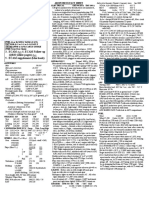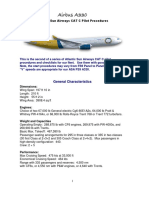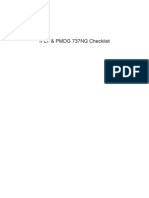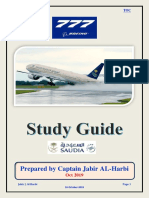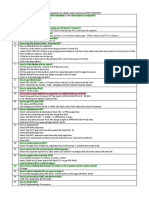0 ratings0% found this document useful (0 votes) 113 views3 pagesEngine Start Notes
Copyright
© © All Rights Reserved
We take content rights seriously. If you suspect this is your content,
claim it here.
Available Formats
Download as PDF or read online on Scribd
ENG start sequence:
cM1
cm2
CALL START (R,L) Engine
Look for EGT red line + duct pressure
1. Select ENG page
2. Look for EGT red line + duct pressure
3,_Start selector to START
Fuel control switch RUN
Monitor start sequence
Monitor start sequence
Start sequenci
1. N2
2. Oil pressure @ as N2 increases
3. Oil temperature comes with oil pressure
4. N1around 20 % N2
5. Fuel Flow around 32-35 % N2
6. EGT after FF
7. N2 stabilizes around 70%
N2 Indication
As N2 increases Oil pressure and temperature
Around 20 % N1 rotation
Around 32-36 % FF then EGT
62% Starter cutout
N2 stabilizes around 70%�Start Problems:
(TNSA E)
* Time Exceedance ~)
~ Starter is open but the engine is not starting
+ Ni not rotating
~ At around 20 % N2
~ Call mechanic ask if N1 is rotating ONE START ATTEMPT
* Start shaft failure - Wait until you get EICAS
- All indications run down > - Domemory items then checklist
* Air not sufficient
- You will see duct pressure amber
= N2 slowly increasing
+ EGT exceed the limit 750. (itis hot start)
~ You will see FF increases rapidly to 0.7-1.0
- EGT will exceed red line _
© Hung start: —
- N2 is not rising above 45%
‘+ Hot star (doesn’t exceed the limit): Up to 3 START ATTEMPTS
= You will see FF increases rapidly to 0.7-1.0
~ EGT will approach the red line but will not exceed S— + Wait until you get EICAS
© EGT not rising (No light off): + Do memory items then checklist
~ After FF, EGT will not rise (igniter problem)
* Compressor stall:
- You will hear loud bang noticeable at high power setting
ABORTED ENG START:
* No oil pressure.
+ No oil temperature or hot oil temperature.
+ ENG FUEL VALVE: during start you will not see FF and you will get EICAS, open the ECL, the ECL
will tell you don’t attempt to start the engine. So, you will need to do ABRTD ENG START.
~ Starter valve did not close after N2 reaches 62 %
- Wait until you get E1CAS [EENSRRNUEMSUIROIR , perform the STARTER CUTOUT checklist to
isolate the bleed to the starter to save the starter, then perform the START VALVE checklist�Autostart
Autostart allows the EEC to control fuel and ignition. With the AUTOSTART switch ON, the autostart sequence is initiated
by rotating the START/IGNITION selector to START and moving the FUEL CONTROL switch to RUN. For in-flight windmill
starts the autostart sequence is initiated by moving the FUEL CONTROL switch to RUN.
The START/IGNITION selector opens the starter air valve to begin dry motoring the engine. Moving the FUEL CONTROL
switch to RUN opens the spar fuel valve, but not the engine fuel valve. The proper sequencing of fuel and ignition is
controlled by the autostart system. With the FUEL CONTROL switch positioned to RUN, the EEC opens engine fuel valve
and energizes the igniter(s) at the appropriate N2 RPM.
During autostart, the EEC monitors EGT, N2 RPM, and other engine parameters until the engine reaches idle. During
ground start, the autostart system monitors engine parameters and will abort the start for any of the following:
+ hot start ‘+ no N1 rotation
hung start ‘+ insufficient air pressure for starter operation
+ nO EGT rise ‘+ start time exceeds the starter duty cycle timer.
‘= compressor stall HZ-AK31 - HZ-AK4S
‘+ oll pressure 10 PSI or less
starter shaft failure
HZ-AKI - HZ-AK30, HZ-AK71 - HZ-AKW.
Note: The autostart system does not monitor oil pressure and temperature
HZ-AK31 - HZ-AK4S
Note: The autostart system does not monitor oil temperature.
Ifa hot start, hung start, no EGT rise, or compressor stall is detected, and N2 RPM is less than starter cutout speed, the
EEC turns off fuel and ignition and motors the engine for 4 seconds before making a second or third attempt. The second
attempt uses both igniters. If the second attempt fails, a third attempt is made by adjusting the starting fuel flow. If N2 RPM
is greater than starter cutout speed, the EEC turns off fuel and ignition, closes the starter air valve and allows the engine to
spool down below 30 percent N2 RPM. It then reopens the starter air valve and motors the engine before re-introducing
fuel and ignition for subsequent attempt(s).
On the ground, if all attempts fail, the EEC aborts the start. Fuel and ignition are shut off and the engine is motored for 30
seconds to clear residual fuel. The starter air valve then closes and the START/IGNITION selector releases to the NORM
position. The EICAS caution message ENG AUTOSTART (L or R) is displayed.
HZ-AKI1 - HZ-AK74
On the ground, autostart does not attempt a second or third start if there is no N1 rotation, insufficient air pressure, the
starter shaft fails, the EGT exceeds the start limit line, or the start time exceeds the starter duty cycle. The EICAS caution
message ENG AUTOSTART (L or R) is displayed.
HZ-AKA - HZ-AKW
On the ground, autostart does not attempt a second or third start if there is no N1 rotation, insufficient air pressure, the
starter shaft fails, or the start time exceeds the starter duty cycle. The EICAS caution message ENG AUTOSTART (Lor R)
is displayed,
Note: For in-flight starts, the autostart system temporarily discontinues the start if a preset EGT between the start and
takeoff EGT red line limits is reached, or a hung start is detected. Autostart takes corrective action if some start
problems are detected, but does not abort the start.
Whenever the AUTOSTART switch is selected OFF, the EICAS advisory message ENG AUTOSTART OFF is displayed
and the AUTOSTART switch OFF light illuminates.
